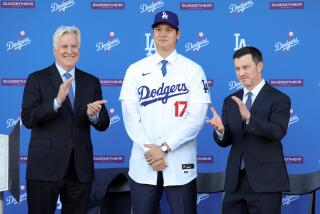Arbitration as American as Baseball, and as Tricky : Dispute: Clinton hopes to end the major league feud with a historic U.S. tool. But the method has its limits.
- Share via
When labor unrest paralyzed the garment industry in Chicago in 1910, a legal scholar who later became one of America’s most celebrated Supreme Court justices, Louis D. Brandeis, proposed an innovative strategy.
In a document known as the Protocol of Peace, Brandeis called for bringing the battling sides under the authority of a neutral third party who would have the power to impose solutions.
The practice, in various forms, eventually was woven into the fabric of the U.S. workplace, creating what Massachusetts Institute of Technology industrial relations expert Thomas A. Kochan calls the “peculiarly American institution” of arbitration.
If President Clinton has his way, that American institution will be used to resolve the labor problems crippling another national tradition: Major League Baseball. The President, after failing in a personal effort Tuesday to settle the 6-month-old baseball strike, called on Congress to impose binding arbitration on the players and owners.
Although Clinton’s proposal is stirring considerable opposition in Congress, binding arbitration has proved to be a durable tool through U.S. labor history. Over the decades, it has settled bitter disputes in such important national industries as steel and railroads.
Today, binding arbitration is more commonly used in many states to hammer out agreements between local governments and unions for police officers, firefighters and other public employees. In many cases, those workers are barred from striking because of the threat to the public welfare.
The practice also has spread to the non-unionized workplace, where it is used to resolve discrimination and wrongful termination disputes between workers and employers without going to court. And in the securities industry, binding arbitration settles battles between investors and brokers.
But for all of its applications, binding arbitration also has drawbacks and limits--limits that could be tested in the baseball showdown.
Experts say the technique yields its best results when the opposing sides already have narrowed their differences, simplifying the arbitrator’s role.
“It’s a bit of a Catch-22,” said Lawrence Kahn, professor of labor economics and collective bargaining at Cornell University in Ithaca, N.Y. “The system works best when you least need it.”
On the other hand, Kahn and other experts say, when fundamental differences exist, the potential grows for ham-handed settlements and imposed solutions that prove unfair or damaging to one side or the other.
Baseball owners know that fact all too well, which may help explain why they resisted White House arm-twisting to submit voluntarily to binding arbitration.
Free agency--a freedom loved by players and loathed by owners--was created in baseball by an arbitrator’s decision in December, 1975. It was arbitrators, too, who found owners guilty of colluding in the 1980s to undermine the free movement of players among teams, leading to a $280-million fine.
Mike Gordon, a lawyer and arbitrator in Kansas City, Mo., says the baseball owners’ reluctance to turn the current labor dispute to arbitration suggests the owners believe they can prevail if the struggle drags on.
“In normal bargaining, if it takes its natural course, the guy with more muscle usually wins,” said Gordon. As such, binding arbitration “is viewed as unfavorable to the party that has more power.”
According to some researchers, another drawback of binding arbitration is its so-called narcotic effect: Once it is used the first time by feuding parties, negotiators increasingly rely on it in the future.
The result, that argument goes, is that bargaining positions become more extreme in future negotiations. “There’s an assumption that the arbitrator will settle it, so why compromise,” said MIT’s Kochan. As a consequence, “clearly you don’t want to use it in every case.”
On the other hand, the threat of a settlement imposed through binding arbitration can make negotiators more flexible, said William B. Gould IV, chairman of the National Labor Relations Board and a former baseball salary arbitrator.
“The uncertainty of where arbitration will take the process and the parties frequently promotes and enhances voluntary bargaining,” Gould said. “It’s because of the fear of the unknown.”
The biggest advantages of binding arbitration, however, are straightforward: It settles seemingly intractable disputes and prevents strikes, particularly in crucial public-sector jobs. Currently, for example, the U.S. Postal Service is in binding arbitration with union workers.
While Kahn said he does not regard the possibility of binding arbitration as “a good development” for baseball, he added that “the owners and players are so far apart, there may be no alternative.”
Binding arbitration comes in various forms and serves various purposes. But in labor-management disputes, there are two types: grievance and interest.
Grievance arbitration is far more common. Typically it involves disputes over an individual union worker who has been disciplined or fired, or it involves interpretation of part of a labor contract. If the parties cannot resolve the dispute on their own, both agree to take their differences to an arbitrator, who generally adopts the position of one side or the other.
Interest arbitration involves broader issues and most often comes into play when two sides cannot agree on a new contract, as is the case with the baseball dispute.
Sometimes interest arbitration rules require that each side put up its best contract offer, with the arbitrator picking one or the other. That is the practice with baseball salary disputes. In other circumstances, the two sides may give the arbitrator broad discretion to devise a compromise.
It remains unclear which of these two general approaches would be applied to the baseball strike if it goes to binding arbitration.
Edgar A. Jones Jr., emeritus professor of law at UCLA, has decided more than 1,200 cases in his 42 years as an arbitrator. Jones said that while virtually all unionized workplaces provide for binding arbitration, only about 200 non-union employers in the country--including TWA and Northrop Grumman Corp.--make the procedure available to their employees.
Still, in recent years, about 70,000 disputes of various kinds have gone to binding arbitration annually. Despite complaints by workers at non-union organizations that arbitration often is biased against the employee, Jones and some other experts expect the practice to continue spreading as a means of reaching settlements without resorting to the courts.
While binding arbitration is “the very last, most extreme way to resolve disputes,” said NLRB Chairman Gould, nothing does as good a job of “concentrating the minds” of warring parties.
* GOP BALKS AT ARBITRATION: Republican leaders give chilly reception to Clinton plan. C1
(BEGIN TEXT OF INFOBOX / INFOGRAPHIC)
The Commissioner-in-Chief
There is no executive action President Clinton can take to order players back to work. When a national emergency is involved, for example in a rail or steel strike, a president can order action. Since there are no federal employees or national emergency involved, he has no real powers and must turn to Congress, which would then pass legislation demanding action.
3 TYPES OF LAWS CONGRESS COULD IMPOSE
Option 1: Congress can pass a bill imposing a settlement under the terms determined by the White House and Congress, the boldest possible decision by the federal government.
Option 2 (Clinton’s Choice): The bill that Clinton proposed Wednesday requires that both sides submit to binding arbitration by a three-person panel appointed by the White House.
Options 3: Congress could take up legislation to strip Major League Baseball of its anti-trust exemptions. This would only pressure owners to bargain and not neceeary force an end to the strike.
PAST PRESIDENTIAL INVOLVEMENTS
Some earlier examples of presidential intervention in labor disputes:
Harry S. Truman: In May, 1946, Truman threatened to draft all striking railroad workers and have the Army run the trains. They backed down and went back to work.
John F. Kennedy: In April, 1962, Kennedy denounced a large increase in prices by U.S. Steel to help it pay for a new wage agreement. He demanded the company roll back the increases, contending they violated price guidelines. U.S. Steel complied.
Ronald Reagan: In August, 1981, Reagan fired striking air-traffic controllers after they refused his order to return to work. Twelve years later, President Clinton lifted the ban.
Sources: Times Washington Bureau, Associated Press
More to Read
Go beyond the scoreboard
Get the latest on L.A.'s teams in the daily Sports Report newsletter.
You may occasionally receive promotional content from the Los Angeles Times.











